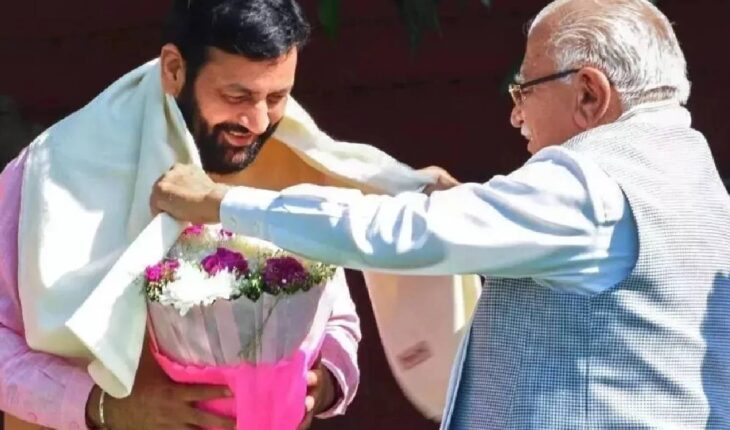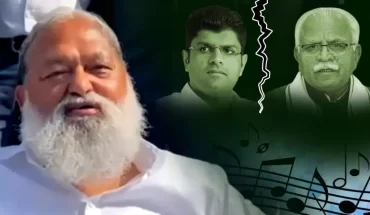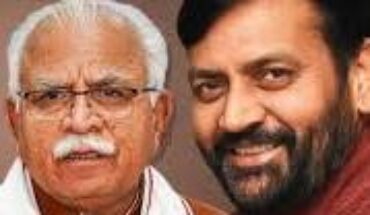Chandigarh: In the ever-evolving landscape of Indian politics, transitions of power often carry the weight of anticipation and intrigue. Nayab Saini’s ascent to the position of Haryana’s 11th Chief Minister on March 12 has sparked a keen interest not just for the policies he’s set to implement, but also for the figure lingering in his shadow: his predecessor, Manohar Lal Khattar. The presence of Khattar alongside Saini has sparked numerous speculations and raised eyebrows across the political spectrum. Is it rooted in sincere mentorship, with Saini regarding Khattar as his guiding light? Or does it mask a more strategic agenda, meticulously crafted by higher echelons of political power?
In every official and personal engagement, the duo’s camaraderie remains unmistakable. Khattar’s ubiquitous presence during Saini’s visits, whether official or personal, invites scrutiny into the dynamics at play. Could it be interpreted as a genuine display of guru-shishya affection, with Saini seeking Khattar’s sage counsel? Or does it hint at a carefully orchestrated plan to ensure Khattar retains a prominent position in the political limelight?
Guru-Shishya Affection or Political Strategy
The recent inauguration of the Sant Shiromani Samark in Kurukshetra on March 15 provided yet another tableau for this curious dynamic. While Saini’s association with Khattar may be interpreted as a genuine display of guru-shishya affection, it also raises questions of a broader political strategy at play. The deliberate efforts to keep Khattar in the limelight, as evidenced by official press releases of the Public Relations department and joint appearances, hint at a calculated move to leverage his popularity and administrative experience for the party’s benefit. This begs the question: Is Manohar Lal’s mentorship of Saini driven solely by personal admiration, or does it serve a larger political agenda orchestrated by the BJP’s high command?
The joint appearance of Saini and Khattar during the roadshow from Nadha Sahib Gurudwara in Panchkula to Garounda on March 19 serves as the latest chapter in this saga. It prompts reflection on whether this seemingly symbiotic relationship is driven by genuine warmth or harbours calculated ambitions, perhaps positioning Khattar for a potential resurgence. Besides this, Saini’s personal rituals, such as poojas at his residence and visits to revered sites like the Mata Mansa Devi Temple, have witnessed Khattar’s active participation, adding layers to the narrative.
Even in the swearing-in ceremony of the new cabinet of Nayab Singh, which took place at the Haryana Raj Bhavan on March 19, Khattar was present.
While political transitions have unfolded in other BJP-led states, such as Uttarakhand, Gujarat, and Madhya Pradesh, the unique bond between Saini and Khattar sets Haryana apart. It serves as a captivating case study, inviting speculation about the intricate machinations within the corridors of power.
Implications for Governance
The implications of this mentorship dynamic extend beyond political optics. Saini’s close association with Khattar raises concerns about the autonomy and decision-making authority of the current Chief Minister. While mentorship can provide valuable guidance and support, an overreliance on the advice of a predecessor may hinder Saini’s ability to establish his own leadership style and agenda for governance. Moreover, it raises questions about the continuity of policies and programs initiated by Khattar’s administration and the extent to which Saini will chart a new course for Haryana’s development.
Political Strategy and Future Prospects
From a strategic standpoint, the mentorship narrative between Saini and Khattar offers insights into the BJP’s approach to power consolidation and succession planning. By fostering a close bond between the incumbent and former Chief Minister, the party may seek to maintain stability and continuity in Haryana’s political landscape while also grooming Saini as a potential long-term leader. However, the success of this strategy hinges on Saini’s ability to strike a balance between honoring Khattar’s legacy and asserting his own vision for the state.
In conclusion, it would not be wrong to say that the show of affection between Manohar Lal Khattar and Nayab Saini in Haryana presents a complex interplay of personal dynamics, political strategy, and governance implications. As this narrative continues to unfold, it underscores the intricate relationships and power dynamics within the BJP and raises broader questions about leadership succession, autonomy, and the future direction of Haryana’s politics. Ultimately, whether this mentorship fosters stability and continuity or inhibits innovation and independent leadership remains to be seen.






